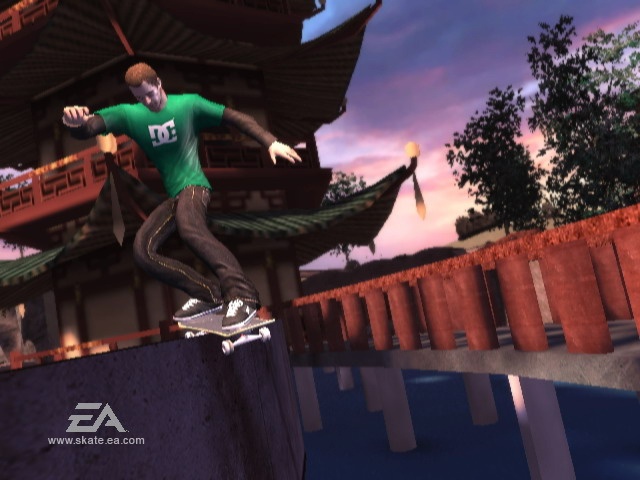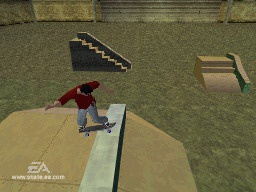Skate It Updated Hands-On
We take a deeper look at the story mode, replay editor, and customizable levels.
Since Skate It was first unveiled this past May, we've had the chance to take a few different looks at the game: initial balance board impressions, a quick run through the career mode, and some hands-on time with a few multiplayer aspects. Recently, though, we spent some quality time with a virtually final build of both the Wii and DS versions of Skate It. Besides getting a better feel for what each game's unique control schemes have to offer once you settle into them, we've been able to pick up on a few other features that we hadn't seen.

We've talked about the control schemes before, but here's a rundown for those who aren't familiar with the way EA has seen fit to bring skateboarding controls to Nintendo's unique inputs. In the Wii version, you'll be flicking the Wii Remote just like a skateboard deck to pull off ollies and flip tricks--for example, ollies are a normal flick, and kickflips are a flick with a slight twist of the wrist. Grabs are done by pulling on the B button, while grinds are a matter of landing on a rail or ledge in your preferred position. You can also choose to use a Wii Balance Board along with the remote to steer and pop the board with your feet while relegating your hands to doing grabs and turns in the air. It's a fun way to control the game, but you lose out on a bit of accuracy compared to using the Wii Remote and Nunchuk setup, which became our favorite control scheme.
The DS version works a bit differently, given the absence of motion controls. With this one it's all about the touch screen, and it works surprisingly well. On the top screen you'll see your skater cruising around fully 3D levels, and on the bottom screen you'll see a skateboard deck. To push, you'll tap anywhere on the touch screen that's not the board--just like how a skater puts his feet on the ground to kick. Doing an ollie is a matter of dragging the stylus from the tail of the board to the nose, doing kickflips requires you to swipe at an angle off the board, and shuv-its are performed by doing a semicircle originating on the tail. It sounds a bit complicated, but it comes together quite well. It should be said, though, that the Wii and DS versions both carry one important hereditary trait from the original Skate, which is that the controls are a lot of fun and really stylish, but they aren't accurate when it comes to fancy moves like laser flips and hard flips. You can do nice-looking moves time and again, but performing the same nice-looking move twice in a row is a bit tough.
While the two versions of Skate It have quite different control schemes, the way you progress through each game is very much the same. Rather than offering the free-roaming San Vanelona of the original Skate, Skate It offers a series of individual levels much in the vein of old Tony Hawk games. Scattered around each of these levels are challenges to perform, ranging from filming sessions to proper contests. You start out with a handful of locations in San Van, like the community center, elementary school, and library, but eventually you'll befriend pro skaters who want to fly you to exotic international locales, like Rio, London, and Barcelona. As you unlock new levels and challenges, you'll also unlock sweet new gear for yourself, such as clothes, shoes, boards, wheels, and trucks. The type of gear you collect ranges from typical branded skater attire, like Girl boards and Emerica shoes, to other, more comedic attire. Want to skate in Paris wearing skin-tight jeans and a baggy American-flag T-shirt? The option is yours.
Once you get outside of the career mode and start cruising on your own in the free skate mode, you'll notice a few more features that carry over from the original Skate. One of these is the ability to access replays on the fly. At any moment you can pull up a menu that has kept track of your last 15 or so seconds of action, and you can trim the footage down and save it for later viewings. (Only the Wii version lets you save; the DS game just allows you to look at the replay.) The editor is pretty bare-bones on both systems when compared to Skate, but to even have the option on systems with no hard drive is very cool. Another feature that has made the transition to both Nintendo systems is the transport marker; you can lay down a marker at any time and then immediately transport back there whenever you like. This comes in handy since the levels tend to be fairly big.

Even with these similarities, Skate It isn't all about the nostalgia that comes along with a faithful re-imagining of a popular game. There are points when it takes the Skate formula and throws it into a blender, like your ability to jump into a level and customize it to your own liking. In the Wii version, there are areas in certain levels where you can move benches, tables, and various obstacles into the configuration that best suits your skating needs. This can be done just for fun or to help you rack up the points with certain objectives that take place in these zones. In the DS version, you can design your own levels from scratch, adding things like ramps, stairs, and rails, and then plop down your own challenges to add some longevity. After that, you can even share the levels online by using the DS's Wi-Fi capabilities.
All in all, it looks like Skate It has managed to hold on to a lot of what made Skate so appealing, while still venturing off into some unexplored territory. We'll have the final word for you when our review hits right around the time of the game's November 19 release.
Got a news tip or want to contact us directly? Email news@gamespot.com
Join the conversation